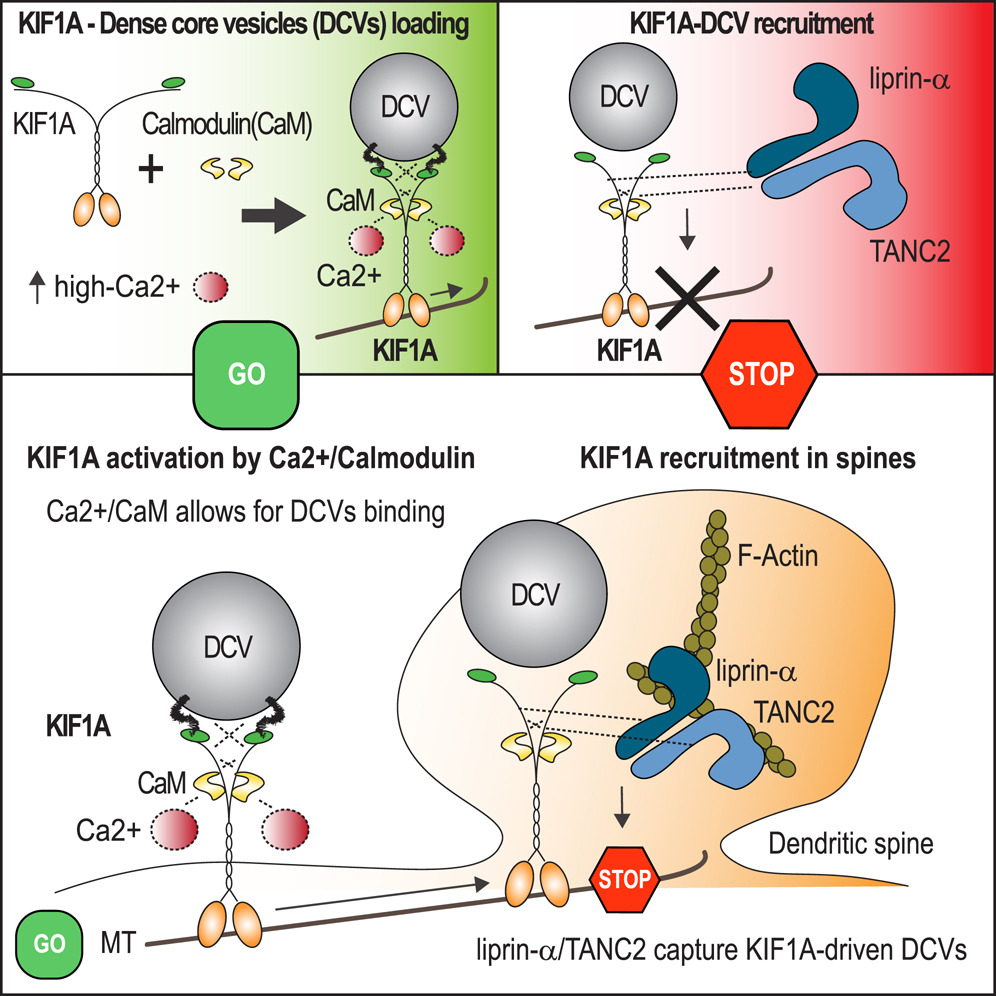#ScienceSaturday posts share exciting scientific developments and educational resources with the KAND community. Each week, Dr. Dominique Lessard and Dr. Dylan Verden of KIF1A.ORG summarize newly published KIF1A-related research and highlight progress in rare disease research and therapeutic development.
From the Archives: KIF1A-Related Research
Regulation of KIF1A-Driven Dense Core Vesicle Transport: Ca2+/CaM Controls DCV Binding and Liprin-α/TANC2 Recruits DCVs to Postsynaptic Sites
KIF1A transport is crucial for the delivery of cargo that promote neuronal communication, but it doesn’t act alone: Like an unloaded semi truck, KIF1A must be loaded up with its cargo, and know where to drop that cargo off, to be effective. In this week’s article, researchers investigated cargo onloading and offloading by studying KIF1A’s interactome, the proteins that work with KIF1A to help it perform its job.
In neurons, dendrites act as receivers – they take in communication from other neurons and send that information to the cell body. Dendrites are always changing, and can create new connections by growing dendritic spines. This process plays a huge role in learning and memory, and it relies on delivery of cargo called Dense Core Vesicles (DCVs) to spines.
In this study, the authors investigated potential proteins that help KIF1A transport DCVs. To identify this interactome, KIF1A was cut up into sections which were incubated with different proteins to pull out ones that bind to KIF1A. Using sections of KIF1A provides information about when proteins interact: KIF1A’s full tail can fold up to inactivate transport, so if a protein can bind to a part of the tail but doesn’t bind to the full tail, that protein might only interact with active KIF1A.
This experiment highlighted proteins that bind with KIF1A:
- Calmodulin binds with calcium to activate many biological processes. It binds to both tail fragments and the full tail of KIF1A, indicating it can bind to inactive or active KIF1A. When the authors made mutant KIF1A that couldn’t bind to calmodulin, it decreased KIF1A’s ability to bind to the DCVs that help dendrites grow.
- TANC-2 is an anchoring protein found in dendritic spines. It binds to tail fragments, but not the full tail of KIF1A, indicating it only interacts with active (transporting) KIF1A. When TANC-2 is depleted or can’t bind to KIF1A, dendritic spines decrease in size.

Based on these findings, the authors proposed that Calmodulin activates KIF1A and allows it to bind to DCVs – it helps load up the truck with its cargo. TANC-2 sits in dendritic spines until the truck comes along, and binds to KIF1A to bring it into the dendritic spine, where it releases its cargo and promotes growth!
So why is this study important for KAND research? First of all, it highlights the role of KIF1A in maintaining and growing dendrites, which could have implications for learning and memory. Second, it shows how mutations outside of KIF1A’s motor domain might contribute to disease. Lastly, proteins that interact with KIF1A may be potential drug targets, or biomarkers for testing KIF1A-based therapeutics.
Rare Roundup
Two Leading Rare Disease Organizations Join Forces to Enable and Accelerate Patient-Led Engagement and Advance Research
Rare disease communities often face the common challenge of having limited resources and tools due to their small size, but one lesson that shows up again and again is that by working as a collective rare disease community can accomplish much more. This large scale patient-centered mission is what drives two nonprofit organizations in the rare disease space. Global Genes is dedicated to educating patient advocates and removing barriers to health equity. RARE-X aims to create a centralized patient-centered platform to accelerate research and therapeutic development across rare diseases. In the spirit of collective action, these organizations have announced a merger to create new opportunities for rare disease patients across the world.
“This patient-focused, and science-driven partnership will change the world. The merger of RARE-X and Global Genes represents a paradigm shift which clearly establishes the patient community as the key to translational research and patient access. The result of this partnership is two forces coming together to create something nobody thought was possible.”
Luke Rosen, Founder of KIF1A.ORG

